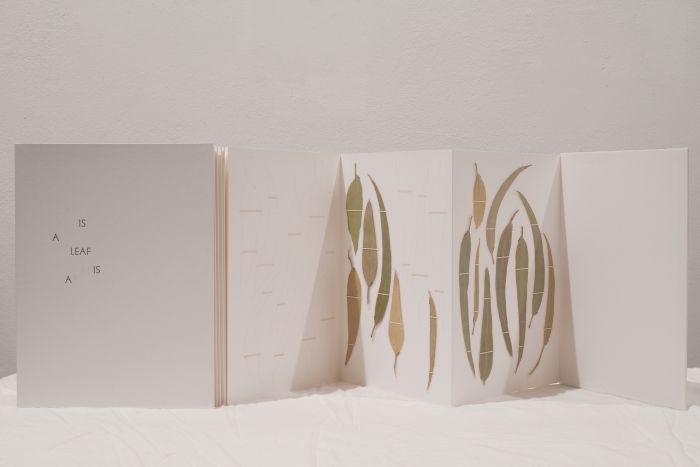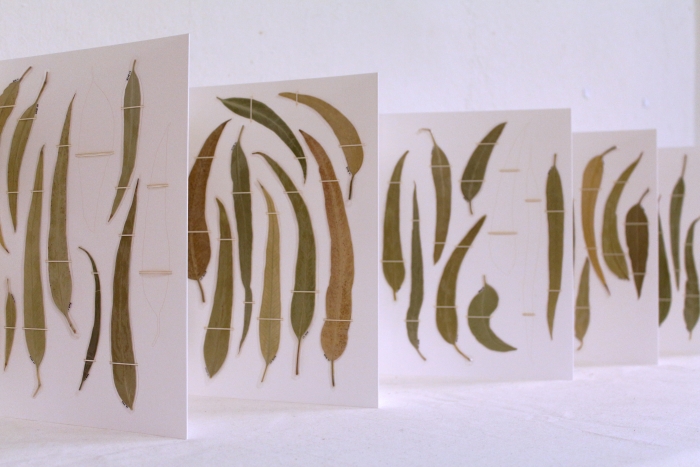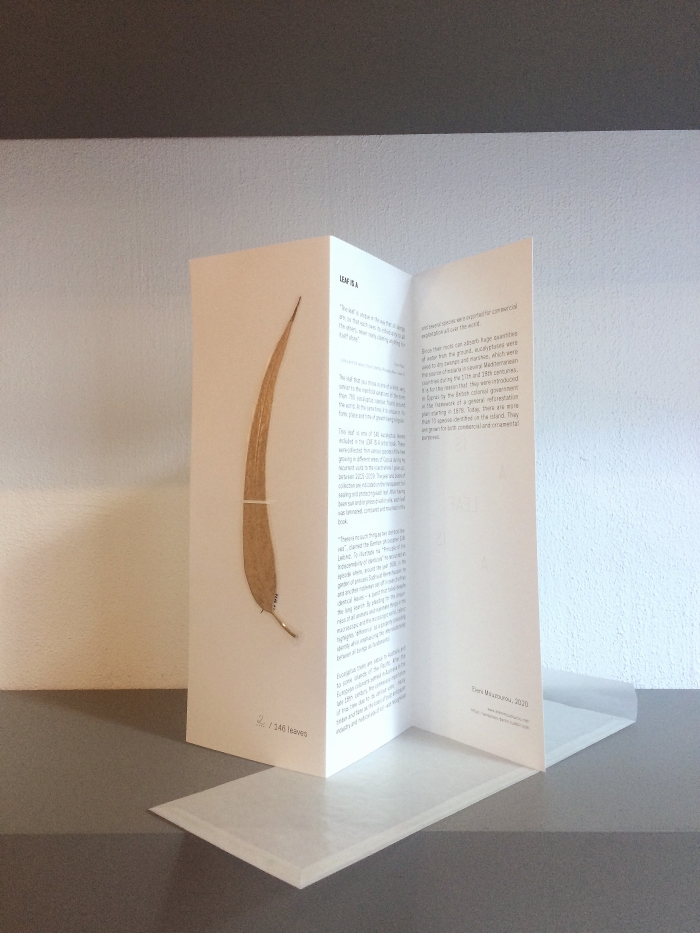Leaf Is A
2019, Artist Book
Leporello: 22,5 x 540 cm
Paper, laminated eucalypt leaves, text
Consultant for botanical information: Dr. Ralf Hand
Bookbinding: Esther Everding
Photos: Sarah Duby
“The leaf is unique in the way that all beings are, so that each owes its individuality to all the others, never really claiming anything for itself alone”.
Peter Pesic, Leibniz and the Leaves: Beyond Identity.
This book contains 146 eucalypt leaves. These were collected individually from various eucalypt tree species growing on the island of Cyprus, where I grew up, during my recurrent visits in 2015-19. After having been sun and/or press dried on site, each leaf was laminated, contoured and mounted in the book. The place and year of collection are indicated on the transparent foil sealing and protecting each leaf. Anything but systematic, this assemblage was guided by a feeling of familiarity and delight I associate with re-encountering variations of this plant, the distinctive fragrance of its leaves, their pointy, curved shapes and the tender pastel shades of aged, fallen leaves. Each leaf included in the book is unique in its form, place and time of growth, reflecting the multiple variations of the more than 700 eucalypt tree species found around the world.
“There is no such thing as two identical leaves”, claimed the German philosopher G.W. Leibniz. To illustrate his “Principle of the Indiscernibility of Identicals” he recounted an episode where, around the year 1695, in the garden of princess Sophia at Herrenhausen, he and another nobleman set off in search of two identical leaves – a quest that failed despite the long search. By pleading for the uniqueness of all animate and inanimate things in the macroscopic and microscopic world, Leibniz highlights ‘difference’ as a property preceding/prior to ‘identity’[a2] while emphasizing the fundamental interrelationships between all beings.
Eucalypts are among the most resilient trees on earth. Depending on the species, some of them can survive up to 400 years in the wild and can sometimes reach a height of more than 90 meters. Due to their highly adaptable properties they can be grown all over the world. While some scientists consider eucalypts as being potentially dangerous for the ecosystems they grow in (they dry the soil through their deep roots and diffuse their oil – toxic in high concentrations – in the soil through fallen leaves), others believe that they cannot harm the ecosystem unless an area’s natural vegetation is vastly removed and replaced by eucalypts.
As with a number of domesticated plants, eucalypts carry a story of displacement determined by human activity. Being native trees to Australia and to some islands of the Pacific, their wood was used by Aboriginal Australians for the manufacture of spears, boomerangs and canoes. From their leaves, Aborigines extracted the essential oil, treasured for its versatile healing power for many centuries. After the European colonists settled in Australia in the late 18th century, the commercial importance of this tree due to its various uses – mainly timber and fibre as the basis of the pulp and paper industry and medical use of oil – was recognised and several species were exported for commercial exploitation.
Since their roots can absorb huge quantities of water from the ground, eucalypts were used to dry swamps and marshes, which were sources of malaria in several Mediterranean countries during the 17th and 18th centuries. It is for this reason that they were introduced in Cyprus by the British colonial government in the framework of a general reforestation plan that started in 1878. Currently, more than 70 species of eucalypt can be found on the island. They are grown for both commercial and ornamental purposes.
2019, Artist Book
Leporello: 22,5 x 540 cm
Paper, laminated eucalypt leaves, text
Consultant for botanical information: Dr. Ralf Hand
Bookbinding: Esther Everding
Photos: Sarah Duby






